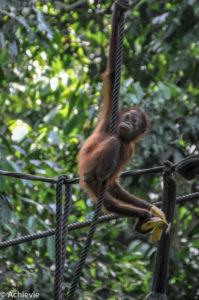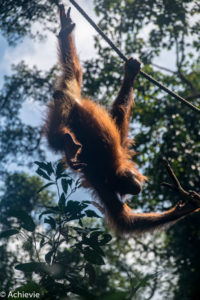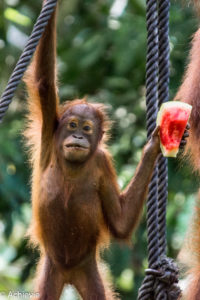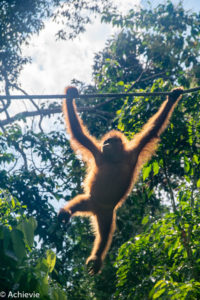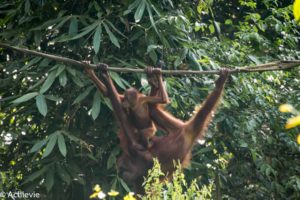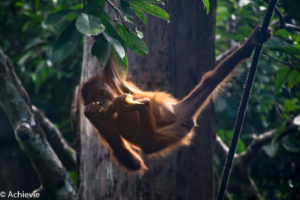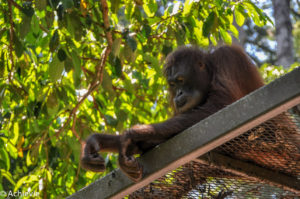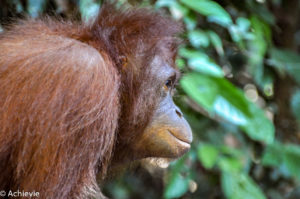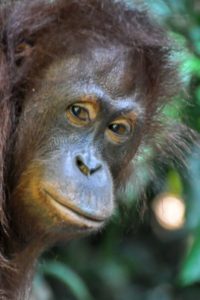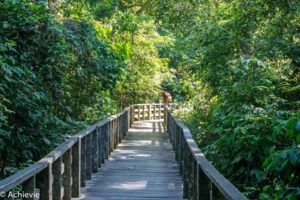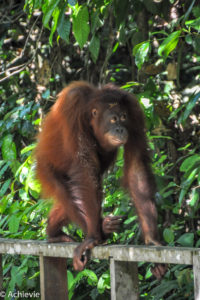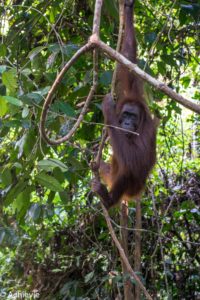How the Sepilok Orangutan Rehabilitation Centre operates
Sepilok Orangutan Rehabilitation Centre is located in the Sabah district in North Borneo, in a protected area at the edge of the Kabili Sepilok Forest Reserve. Its purpose is to rehabilitate orphan orangtuans who have fallen victim to the deforestation and illegal pet trade. You may know it from the Animal Planet series “Meet the Orangutans”.
The orangutans can wander freely around the reserve and the forest – they can come and go as they please, once they are fit to do so. Most of the time is being spent in the forest where they live a natural existence, but they sometimes return to the centre for a free meal. Actually, the less you would see them, the better – because that means that they can care for themselves.
The centre is already active since 1964, founded by an English lady called Barbara Harrison. It’s owned and run by the Sabah Wildlife Department, from which it receives some funds. Additional funding comes from the entrance fees that visitors pay. Given the long and expensive rehabilitation process which can easily take 7 years for an orangutan to return to the wild however, Orangutan Appeal UK also funds projects at the centre, including renovation of equipment, purchase of rescue vehicles as well as employing the care team members and research assistants.
Newcomers undergo a full health check and then have their diet supplemented by daily feedings of milk and bananas. The idea is to keep the additional food boring, so that they are encouraged to set out to look for food themselves. Baby orangutans are being cared for 24/7. They are housed in the nursery, which is a separate section in the rehabilitation reserve. The indoor nursery is where the youngest ones remain. As they are so prone to human illness and as this is a crucial stage in the rehabilitation process, visitors can’t access this section. The outdoor nursery however is accessible. In the wild the orangutan babies learn the climbing skills from their mother and this can take up to six years. In the centre a buddy system is set-up in which a younger ape is paired up with an older one, who then teaches the younger one to develop the skills they need.
Organising your visit
The visitor centre is open to the public all year round, from 8.45am to 4pm and costs 30RM for foreign visitors + a camera fee of 10RM. There’s 2 feedings a day (at 10am and 3pm) – a great opportunity to see them in action. The outdoor nursery is open from 9 to 11am and then again from 2.30 to 4pm. From behind glass walls you can see the younger ones on their final stage of rehabilitation… adorable.
While being in the reserve it’s important to keep to the instructions. You can only use the walkways and you should not approach the apes yourself. And – it should speak for itself – don’t touch them! They are very vulnerable to human diseases. So for their protection, please refrain from hands-on contact, even though they look so cuddly. And again, they are wild animals – the less contact they have with humans, the better. Dependence and familiarity with people eventually reduces their chance to return to the wild.
As such it cannot be guaranteed that you see an orangutan, given the fact that they are wild and free to go where they want to go (which is a good thing!). In fruiting season, when naturally growing food is in abundance, chances are smaller. We went twice and each time saw many of them – sometimes from very close. And in the outdoor nursery there’s always some action to see as well – at least, if it’s not raining. If it is, they can be kept indoors to prevent spreading diseases.
The experience of visiting the centre and seeing these wild apes do their thing is magical. When we first got there, the highlight was feeding time. When the rangers bring the food to the platform, the trees start to shake and orange furry arms and legs are appearing. Cameras are flashing and clicking all over the place, looking all around you to see as much and as many as you can. The next day, we actually focused on the walkways leading up to the feeding platform, so that we could see them coming down from the trees, walking slowly on the handrail of the walkway without too many tourists standing in our way. Even better…
How to help?
You can donate any amount you like towards the care of the orangutans at the centre and the orangutan conservation in general, through this donation page. Or you can choose to adopt an orphan baby. Still, the funds are used in general of course.
We didn’t hesitate. Actually we already wanted to set things in motion when we were there, but as the Liaison officer in charge wasn’t there at the time, we took care of things online, when we were back home. Archie is the cutie that stood out to us. You actually get a lot back for your help – you can choose a package as you like – there’s about 4 options. We took the bundle deal, which is only 40 GBP + 6 GBP for delivery outside of the UK. That covers a year of adoption. A renewal is even less – 30 GBP.
Very soon after we arranged for the adoption on-line we got our package, including a certificate, photos, a DVD and some background about our beloved Archie.
We’ll get an update after 6 months – looking forward to it!

